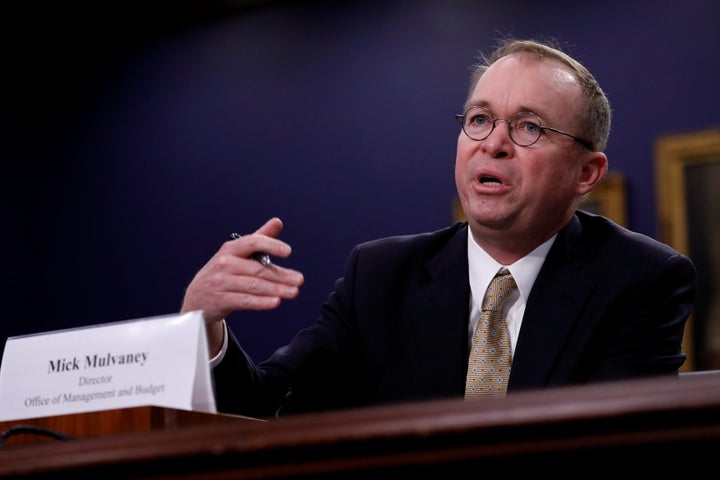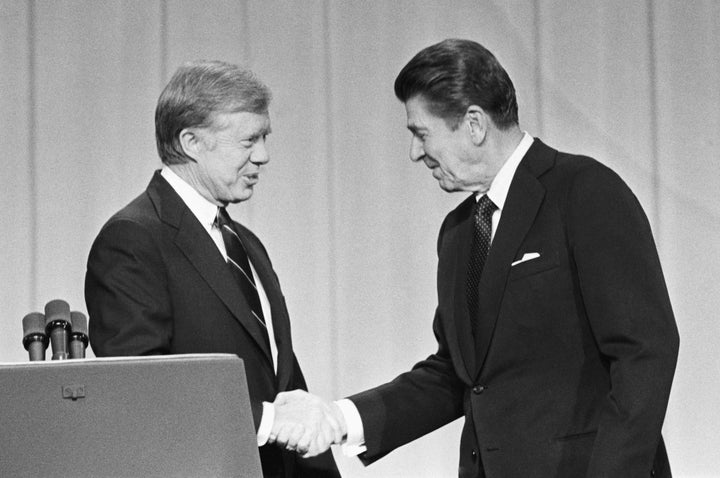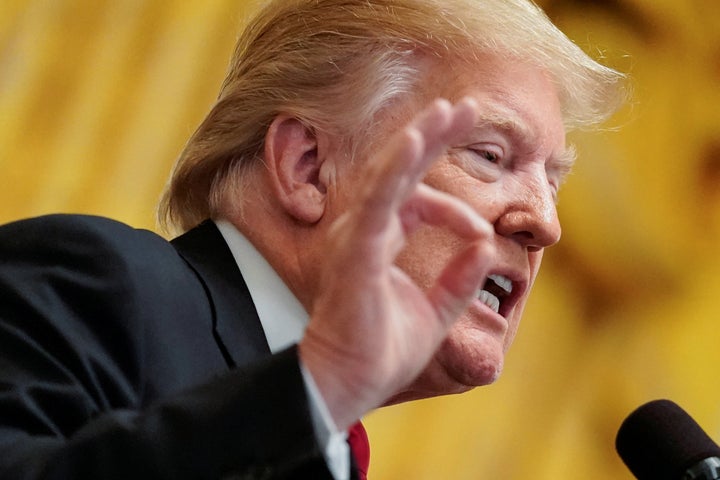
It would have been easy to miss in a news cycle as chaotic as last week’s, but President Donald Trump and his budget director, Mick Mulvaney, just floated a proposal to remake a huge chunk of the federal government. It’s a proposal that targets the most vulnerable members of our society and, despite how dangerous it is, it’s designed to fly under the radar: The entire strategy is cloaked in boringness and bureaucracy.
Trump and Mulvaney have come up with a plan to completely restructure the government, which would require merging the education and labor departments. And buried deep within their outline is a wish list intended to destroy the core government functions that help the poor survive. It may sound like Trump and Mulvaney are pursuing government efficiency, but don’t let them fool you: They’re trying to destroy what’s left of our social safety net.
The biggest moonshot in the plan is the creation of a new agency. Right now, food stamps and other nutrition programs that help the poor stay fed are located in the Department of Agriculture. The Trump-Mulvaney plan would move them out of that department and place them in the Department of Health and Human Services, which would get a new name: the Department of Health and Public Welfare.
Moving the food stamp program, which helps keep low-income residents of one of the wealthiest countries on the planet from starving, is a prelude to destroying it. Currently, food stamps are coupled with farm subsidies in the Department of Agriculture. While that might seem odd, this structure harks back to an era when receiving food stamps meant receiving surplus food from America’s farmers. Tying them together still serves an important purpose: It yokes the needs of urban and rural districts, and thus the interests of progressive and conservative politicians.
“Moving the food stamp program is a prelude to destroying it.”
Decoupling food stamps from agriculture subsidies leaves them far more vulnerable to attack. Conservatives have long pushed to isolate food stamps because that would make the program far easier to defund. In 2013, during a heated House fight over whether to decouple food stamps and the Department of Agriculture, the CEO of the ultra-conservative Heritage Action think tank, Michael A. Needham, urged support for it because it would end the “unholy alliance” and “allow the House to show its conservative values.”
Lumping a bunch of programs into a new agency with “welfare” in the name is also aimed at miring the programs in stigma, which will make them easier to slash. Welfare typically means one specific program, currently known as Temporary Assistance for Needy Families (TANF), which gives a shrinking number of deeply impoverished families cash assistance so they can cover things like car payments and diapers. Benefits today are a measly $429 a month, at the median, for a family of three.
When Ronald Reagan campaigned for president in 1980, he began spinning the yarn of the so-called welfare queen, the mostly mythical black woman who refused to work and instead lived off checks from the government (until shortly before he took office, there was in fact a department named Health, Education and Welfare).

It worked like a charm: By 1989, two-thirds of the country believed that welfare made people dependent and complacent. That sentiment is just as strong today. A majority of Americans wrongly believe that most people who get welfare are black. More than half say the government spends too much on “welfare” and the same proportion thinks we don’t spend enough on “assistance to the poor.” Welfare, of course, is assistance to the poor.
After welfare became associated with phantom hordes of lazy black people, it became all too easy to whittle away at it. In the mid-1990s, President Bill Clinton dealt it a near-fatal blow when he signed welfare reform into law; since then, the number of people enrolled has fallen by nearly two-thirds, and the worth of welfare benefits has fallen in almost every state.
What’s happened to actual welfare foreshadows what will happen to anything else that Trump and Mulvaney dub “welfare” ― that is, anything they’re planning to install in the renamed department. Conservatives are already busy throwing a whole new universe of programs into the “welfare” bucket — not just food stamps but also Medicaid, unemployment insurance and housing assistance. It’s a deliberate strategy: Weaponize the public disgust with “welfare” against other programs that might otherwise garner support, like helping the poor keep a roof over their heads or avoid dying for lack of health care.
“It’s a deliberate strategy: Weaponize the public disgust with 'welfare' against other programs that might otherwise garner support, like helping the poor keep a roof over their heads.”
Trump and Mulvaney’s desire to welfare-ize these programs isn’t just in a name. Their government reorganization proposal includes the creation of a “Council on Public Assistance.”
That council would be empowered to unilaterally impose work requirements on all public programs, without any action from Congress. Some of the most stringent work requirements have already been adopted in TANF, which requires recipients to either have a job or look for one in order to keep getting benefits. But work requirements make many people less likely to be employed, and, in practice, they push them off the rolls by erecting a barrier of paperwork. This denies people a lifeline of cash assistance and, unsurprisingly, they simply stay poor or even end up poorer.
In other words, without enacting an actual cut to the welfare program, work requirements achieve the same goal: serving fewer poor people. Imposing work requirements on programs like Medicaid and rental assistance and enhancing the existing ones in food stamps will serve the same purpose. While purporting to help people find jobs, they’ll instead reduce the rolls ― all while hiding behind the veneer of “government efficiency” and helping the poor achieve “self-sufficiency.”
Then there’s Trump and Mulvaney’s plan for something seemingly small, like the Community Development Block Grant. Their proposal to move it from the Department of Housing and Urban Development to the Department of Commerce is about killing the grants outright.
The alphabet soup grant serves a number of crucial purposes: helping people afford child care, building affordable housing, delivering Meals on Wheels. None of these are easily replaced, and moving the program is as good as eliminating it. As one Senate adviser told The New York Times, Trump and Mulvaney’s proposal to move it from its current home in HUD, where career officials are more inclined to pay attention to the needs of the impoverished communities it serves, is a way to “strangle” it. It’s a backdoor tactic to accomplish a goal Mulvaney hasn’t been able to realize another way: eliminating the grant’s funding completely, which is what he called for in the budgets he’s authored for the president.

It’s true that the bureaucracy running the programs that keep the poorest housed and alive could use a revamp. The red tape that the poor must untangle if they want assistance is thick. Programs often don’t coordinate with each other, caseworkers are stretched thin and millions who are eligible for help don’t get it.
But clearing away red tape is not what motivates Trump and Mulvaney. They tipped their hand when they designed multiple budgets that have would deeply cut the programs that help poor Americans survive. They revealed the truth by seeking to impose work requirements through any means necessary. This latest plan isn’t about making sure the government serves the poor as well as it can. It’s about isolating the programs the poor need to live and shaming anyone who tries to avail themselves of them.
This is not a plan from Trump the businessman president, streamlining government and making it more efficient. This is from Trump the lifelong hater of welfare, who has railed against the program since at least the 1970s. It’s not coming from the sleek and supposedly technocratic Jared Kushner wing of the White House. It’s coming from the Mick Mulvaney wing, which wants to burn the government to the ground.
Under the guise of seemingly small tweaks like restructuring and semantics, Trump and Mulvaney just fired a direct shot at the needs of country’s most economically vulnerable families. Don’t be fooled: Their benign-looking proposal is an advance in their war on the poor.
Bryce Covert is an independent journalist writing about the economy. She is a contributing Op-Ed writer at The New York Times and a contributing writer at The Nation.
